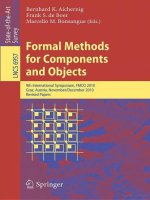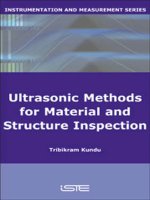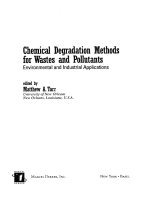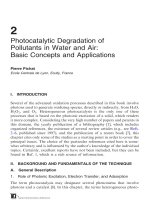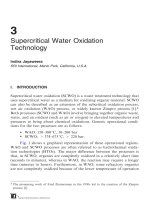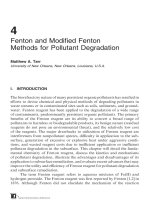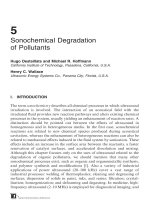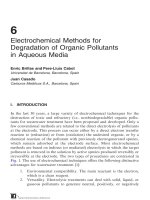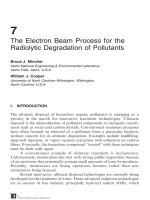Methods for shortening and extending the carbon chain in carbohydrates
Bạn đang xem bản rút gọn của tài liệu. Xem và tải ngay bản đầy đủ của tài liệu tại đây (2.97 MB, 243 trang )
Methods for
Shortening and Extending
the Carbon Chain in
Carbohydrates
Ph.D. Thesis
By
Rune Nygaard Monrad
December 2008
Department of Chemistry
Technical University of Denmark
Methods for
Shortening and Extending
the Carbon Chain in
Carbohydrates
Rune Nygaard Monrad
Ph.D. Thesis
December 2008
Department of Chemistry
Technical University of Denmark
Kemitorvet
Building 201
DK-2800 Kgs. Lyngby
Denmark
Preface
i
Preface
This thesis describes the work carried out during my three years as a Ph.D. student in Center for
Sustainable and Green Chemistry at the Technical University of Denmark. In addition to research
within the fields of organometallic and carbohydrate chemistry at the Technical University of
Denmark, I had the opportunity to become acquainted with chemical biology during a six months
research stay at University of Oxford. My period as a Ph.D. student has been very fruitful for me
not only by means of education and achieving academic and technical qualifications, but also with
respect to personal development as an individual and as a scientist. Many people have contributed
to the present work, and most of all, I would like to express my gratitude to professor Robert
Madsen. During the last three years of Ph.D. study, my theoretical and experimental skills have
improved considerably. In particular, Robert Madsen’s support and guidance through critical
decisions and his ability to suggest improvements of both overall strategies and specific reaction
conditions have had a huge impact on the success of the projects I have been involved in. The
decarbonylation team: Mike Kreis and Esben Taarning are thanked for good discussions, and
Charlotte B. Pipper and Mette Fanefjord are acknowledged for collaborations on the calystegine and
gabosine projects. A special thanks goes to Lars Linderoth for lots of fun and great company in the
lab. The Department of Chemistry building 201, in particular the Madsen group, are gratefully
acknowledged for invaluable help and for always maintaining an enthusiastic and positive spirit. I
would like to thank professor Benjamin G. Davis for giving me the opportunity to work within such
an interesting field of research in an interdisciplinary and highly dynamic group. The entire Davis
group, in particular James, Conor, Justin and Nicola are thanked for invaluable help and good times
in the lab. I am grateful to professor Andrew V. Stachulski for providing acyl glucuronide samples.
Furthermore, Katja Rohr-Gaubert and Thomas Jensen are thanked for proofreading parts of this
thesis. Last but not least, the Technical University of Denmark, Center for Sustainable and Green
Chemistry, Danish Chemical Society, Civilingeniør Frants Allings Legat, Vera & Carl Johan
Michaelsens Legat, Ulla & Mogens Folmer Andersens Fond, Krista & Viggo Petersens Fond,
Fabrikant P. A. Fiskers Fond, Knud Højgaards Fond, Otto Mønsteds Fond and Oticon Fonden are
gratefully acknowledged for financial support.
_____________________
Rune Nygaard Monrad
Lyngby, December 2008
Rune Nygaard Monrad – Ph.D. Thesis
ii
Abstract
Carbohydrates play a central role in a variety of physiological and pathological processes such as
HIV, cancer and diabetes. The understanding of these processes and the development of specific
therapeutic agents is relying on the ability to chemically synthesize unnatural sugars,
glycoconjugates and carbohydrate mimetics. Such polyhydroxylated compounds are conveniently
synthesized from carbohydrates, however, due to the scarcity of many sugars from nature, efficient
methods for transformation of readily available carbohydrates into valuable chiral building blocks
are required. The work presented in this thesis focuses on the development and application of
transition metal mediated methods for shortening and extending the carbon chain in carbohydrates
thereby providing access to lower and higher sugars.
A new catalytic procedure for shortening unprotected sugars by one carbon atom has been
developed. By means of a rhodium-catalyzed decarbonylation of the aldehyde functionality, aldoses
are converted into their corresponding lower alditols in yields around 70%. The reaction is
performed with 8% of the catalyst Rh(dppp)
2
Cl in the presence of small amounts of pyridine to
facilitate mutarotation. The procedure has been employed as the key step in a short five-step
synthesis of the unnatural sugar
L
-threose in 74% overall yield from
D
-glucose.
8% Rh(dppp)
2
Cl
6% pyridine
diglyme/DMA
162 °C
OH
OH
R
OH
O
OH
HO
HO
R
OH
OH
R = H, CH
3
, CH
2
OH
+
CO
A zinc-mediated one-pot fragmentation-allylation reaction has been used to elongate
D
-glucose and
D
-ribose by three carbon atoms thereby producing carbohydrate-derived α,ω-dienes, which have
been converted into the natural products calystegine A
3
and gabosine A. The glycosidase inhibitor
calystegine A
3
was produced by two similar routes from commercially available methyl
α-
D
-glucopyranoside in 13 and 14 steps with 8.3 and 5.3% overall yield, respectively. The present
work thereby constitutes the shortest synthesis of enantiomerically pure calystegine A
3
, and
furthermore, it enables the absolute configuration of the natural product to be determined. Gabosine
A has been prepared in nine steps and 13.9% overall yield from
D
-ribose, and this synthesis
provides the first route to gabosine A from an abundant carbohydrate precursor.
Abstract
iii
calystegine A
3
NH
HO
OH
HO
HO
HO
O
OH
gabosine A
D
-glucose
D
-ribose
13 steps
9 steps
During an external stay at University of Oxford, the metabolism of nonsteroidal anti-inflammatory
drugs (NSAIDs) has been investigated. It was found that known acyl glucuronide metabolites of
ibuprofen and several analogues modify human plasma protein under conditions encountered in
therapy. Two different kinds of protein modification occur depending on the structure of the parent
drug. The obtained results strongly suggest that irreversible modification of human proteins takes
place during treatment with carboxylic acid containing drugs such as NSAIDs. Furthermore, the
observed reactivity of these metabolites with respect to protein modification may provide an
explanation for the severe toxicity that has led to the withdrawal of certain carboxylate drugs.
O
HO
HO
HO
O
O
OH
O
Drug
+
Protein
Lys
N
H
O
Drug
Protein
O
HO
O
HO
O
OH
O
Drug
O
HO
O
HO
O
OH
O
Drug
Lys Protein
Protein
OH
Glycosylation
Acyl
migration
Transacylation
+
N
H
Rune Nygaard Monrad – Ph.D. Thesis
iv
Resumé
Kulhydrater spiller en central rolle i mange forskellige fysiologiske og patologiske processer såsom
HIV, cancer og diabetes. Forståelsen af disse processer samt udviklingen af specifikke lægemidler
afhænger i høj grad af kemisk at kunne syntetisere unaturlige sukkerstoffer samt stoffer, der
imiterer kulhydrater. Ideelt set fremstilles sådanne polyhydroxylerede forbindelser fra kulhydrater,
men på grund af meget lav tilgængelighed af mange sukkerstoffer fra naturens side, er der behov for
effektive metoder til at omdanne tilgængelige kulhydrater til værdifulde kemiske byggeblokke. Det
arbejde, der præsenteres i denne afhandling, fokuserer på udvikling og anvendelse af metoder, hvor
overgangsmetaller benyttes til at forkorte og forlænge sukkerstoffers kulstofkæde og dermed giver
adgang til ellers utilgængelige kulhydrater.
En ny katalytisk metode til at forkorte ubeskyttede kulhydrater med ét kulstofatom er blevet
udviklet. Ved hjælp af en rhodium-katalyseret decarbonylering af aldehyd-gruppen kan
monosakkarider omdannes til de tilsvarende forkortede polyoler i udbytter omkring 70%.
Reaktionen udføres med rhodium-katalysatoren Rh(dppp)
2
Cl i tilstedeværelse af en lille smule
pyridin, der katalyserer mutarotation mellem kulhydratets hemiacetal- og aldehydform. Den
udviklede metode er blevet anvendt som nøgletrin i en kort syntese af det unaturlige sukkerstof
L
-threose i 74% samlet udbytte i fem trin fra
D
-glukose.
8% Rh(dppp)
2
Cl
6% pyridin
diglyme/DMA
162
°
C
OH
OH
R
OH
O
OH
HO
HO
R
OH
OH
R = H, CH
3
, CH
2
OH
+
CO
Som en del af fremstillingen af naturstofferne calystegin A
3
og gabosin A er
D
-glukose og
D
-ribose
blevet forlænget med tre kulstofatomer ved hjælp af en zink-medieret fragmentering-
allyleringsreaktion. Calystegin A
3
blev fremstillet på to lidt forskellige måder i 13 og 14 trin med
henholdsvis 8,3 og 5,3% overordnet udbytte fra
D
-glukose. Herved er det lykkedes at udvikle den
hidtil korteste syntese af naturligt forekommende calystegin A
3
i enantiomerisk ren form, hvilket
blandt andet har muliggjort, at den absolutte konfiguration af naturstoffet er blevet bestemt.
Fremstillingen af gabosin A blev gennemført i ni trin med 13,9% samlet udbytte fra
D
-ribose og
Resumé
v
udgør den første synteserute til gabosin A, der gør brug af et let tilgængeligt kulhydrat som
startmateriale.
calystegin A
3
NH
HO
OH
HO
HO
HO
O
OH
gabosin A
D
-glukose
D
-ribose
13 trin
9 trin
I løbet af et eksternt ophold ved Oxford Universitet er metabolismen af nonsteroidale anti-
inflammatoriske lægemidler (NSAID’er) blevet undersøgt. Under forsøgsbetingelser, som forventes
at kunne forekomme ved behandling med ibuprofen, blev det observeret, at kendte acylglukuronid-
metabolitter af ibuprofen og flere analoger reagerer med et humant plasmaprotein. Afhængig af
strukturen af lægemidlet blev der observeret to forskellige former for protein-modifikation, og de
her opnåede resultater indikerer kraftigt, at der foregår irreversibel modifikation af proteiner i
mennesker, når der indtages lægemidler, der indeholder en carboxylsyre-gruppe (f.eks. NSAID’er).
Endvidere kan disse metabolitters reaktivitet med hensyn til modifikation af proteiner give en mulig
forklaring på den toxicitet, der har været skyld i, at visse lægemidler indeholdende en carboxylsyre-
gruppe er blevet trukket tilbage fra markedet.
O
HO
HO
HO
O
O
OH
O
Læge-
middel
+
Protein
Lys
N
H
O
Læge-
middel
Protein
O
HO
O
HO
O
OH
O
Læge-
middel
O
HO
O
HO
O
OH
O
Læge-
middel
Lys Protein
Protein
OH
Glykosylering
Acyl-
migrering
Transacylering
+
N
H
Rune Nygaard Monrad – Ph.D. Thesis
vi
Publications
vii
Publications
At the time for submission of this thesis, the research had resulted in the following scientific
publications. Copies of the manuscripts are included in Appendix IV at the end of this thesis. In
addition to these publications, work is in progress to convert the literature described in chapter 2
and the research presented in chapter 4 into a review and a full paper, respectively.
1) Rune Nygaard Monrad, Robert Madsen, Rhodium-Catalyzed Decarbonylation of Aldoses,
Journal of Organic Chemistry 2007, 72, 9782-9785.
2) Rune Nygaard Monrad, Mette Fanefjord, Flemming Gundorph Hansen, N. Michael E. Jensen,
and Robert Madsen, Synthesis of Gabosine A and N from Ribose by the Use of Ring-
Closing Metathesis, European Journal of Organic Chemistry 2009, 396.
3) Rune Nygaard Monrad, James C. Errey, Mazhar Iqbal, Xiaoli Meng, Lisa Iddon, John R.
Harding, Ian D. Wilson, Andrew V. Stachulski, Benjamin G. Davis, Dissecting the Reaction
of Phase II Metabolites of Ibuprofen and Other NSAIDS with Human Plasma Protein,
Nature Medicine, submitted.
Rune Nygaard Monrad – Ph.D. Thesis
viii
Abbreviations
))) sonication
A, Ala alanine
Ac acetyl
AG 1-β-O-acyl glucuronide
AIBN 2,2’-azo bisisobutyronitrile
aq. aqueous
Asp asparagine
BINAP 2,2’-bis(diphenylphosphino)-
1,1’-binaphthyl
Bis-Tris 1,3-bis[tris(hydroxymethyl)-
amino]propane
Bn benzyl
Boc tert-butoxycarbonyl
bp boiling point
BSA bovine serum albumin
Bu butyl
Bz benzoyl
C cytidine
C, Cys cysteine
CAN cerium(IV) ammonium nitrate
Cbz carboxybenzyl
CMP cytidine 5’-monophosphate
COD 1,5-cyclooctadiene
COE cyclooctene
Cp* η
5
-pentamethylcyclopentadienyl
CSA camphorsulfonic acid
CstII sialyl transferase
Cy cyclohexyl
D aspartate
d days
d doublet (NMR)
Da Dalton
DABCO 1,4-diazabicyclo[2.2.2]octane
DAH 3-deoxy-
D
-arabino-hept-2-
ulosonic acid
DBU 1,8-diazabicyclo[5.4.0]undec-7-
ene
DCC dicyclohexylcarbodiimide
DCM dichloromethane
DDQ 2,3-dichloro-5,6-dicyano-1,4-
benzoquinone
de diastereomeric excess
DHP 3,4-dihydro-2H-pyran
DIAD diisopropyl azodicarboxylate
DIB (diacetoxyiodo)benzene
diglyme diethyleneglycoldimethylether
DMA N,N-dimethylacetamide
DMAP 4-dimethylaminopyridine
DMDO dimethyldioxirane
DMF N,N-dimethylformamide
DMP Dess-Martin Periodinane
DMSO dimethylsulfoxide
DPPA diphenylphosphoryl azide
dppb 1,4-bis(diphenylphosphino)butane
dppe 1,2-bis(diphenylphosphino)ethane
dpph 1,6-bis(diphenylphosphino)hexane
dppm bis(diphenylphosphino)methane
dppp 1,3-bis(diphenylphosphino)propane
DTT 1,4-dithiothreitol
E glutamate
EDTA ethylenediamine tetraacetic acid
ee enantiomeric excess
ent enantiomer
eq. equivalent(s)
ESI electron spray ionization
Et ethyl
EWG electron-withdrawing group
F phenylalanine
G glycine
Gal galactose
GalT galactosyl transferase
GlcNAc N-acetylglucosamine
Grubbs’ 2
nd
generation catalyst
(PCy
3
)(C
3
H
4
N
2
Mes
2
)Cl
2
Ru=CHPh
H, His histidine
h hour(s)
HATU o-(7-azabenzotriazol-1-yl)-
N,N,N’,N’-tetramethyluronium
hexafluorophosphate
HEPES 4-(2-hydroxyethyl)-1-piperazine-
ethanesulfonic acid
HPLC high performance liquid
chromatography
HSA human serum albumin
I isoleucine
IBX 2-iodoxybenzoic acid
Im imidazolyl
IME 2-imino-2-methoxyethyl
IR infrared
K lysine
K(+) modified lysine
Abbreviations
ix
KDG (4S,5R)-
D
-2-keto-3-deoxy-
gluconic acid
KDN 3-deoxy-
D
-glycero-
D
-galacto-
non-2-ulosonic acid
KDO 3-deoxy-
D
-manno-oct-2-
ulosonic acid
K
i
inhibition constant
L, Leu leucine
LacNAc N-acetyllactosamine
LC liquid chromatography
LiHMDS lithium bis(trimethylsilyl)-amide
Lys lysine
M methionine
m multiplet (NMR)
MALDI matrix-assisted laser desorption
and ionization
Me methyl
Mes mesityl
min minutes
MOM methoxymethyl
MOPS 3-(N-morpholino)propane-
sulfonic acid
mp melting point
MS mass spectrometry
MS molecular sieves
N asparagine
n.d. not determined
NBS N-bromosuccinimide
NHS N-hydroxysuccinimide
NMM N-methylmorpholine
NMO N-methylmorpholine oxide
NMP N-methyl-2-pyrrolidinone
NMR nuclear magnetic resonance
NPht N-phthalimidyl
NSAID nonsteroidal anti-inflammatory
drug
Oxone potassium peroxymonosulfate
p pentet (NMR)
P proline
PAGE polyacrylamide gel
electrophoresis
PBS phosphate-buffered saline
PCC pyridinium chlorochromate
PDC pyridinium dichromate
PG protective group
Ph phenyl
Piv pivaloyl
PMB p-methoxybenzyl
PPTS pyridinium p-toluenesulfonate
Pr propyl
Q glutamine
q quartet (NMR)
R arginine
rac racemic
RDS rate-determining step
rt room temperature
S serine
s singlet (NMR)
sat. saturated
SDS sodium dodecylsulfate
sec seconds
SiaT sialyl transferase
T threonine
t triplet (NMR)
TBDMS tert-butyldimethylsilyl
TBDPS tert-butyldiphenylsilyl
Tf trifluoromethanesulfonyl
TFA trifluoroacetic acid
THF tetrahydrofuran
THP 2-tetrahydropyranyl
TLC thin layer chromatography
TMS trimethylsilyl
TOF time of flight
Tol toluene
TPPTS triphenylphosphane-3,3’,3’’-
trisulfonic acid trisodium salt
Tr trityl
triphos bis(2-diphenylphosphinoethyl)-
phenylphosphine
Tris tris(hydroxymethyl)aminomethane
Ts toluenesulfonyl
TS transition state
UDP uridine 5’-diphosphate
UV ultraviolet
V valine
W tryptophan
Y tyrosin
Rune Nygaard Monrad – Ph.D. Thesis
x
Contents
1 The diverse nature of carbohydrates 1
2 Methods for shortening and extending the carbon chain in carbohydrates 3
2.1 Methods for shortening the carbon chain in carbohydrates 3
2.1.1 Ruff degradation 3
2.1.2 Periodate cleavage 5
2.1.3 Alkoxy radical fragmentation 6
2.1.4 PCC-induced shortening of β-azido alcohols 9
2.2 Methods for extending the carbon chain in carbohydrates 10
2.2.1 The Kiliani ascension 10
2.2.2 The Sowden homologation 12
2.2.3 Chain elongation by means of the Baylis-Hillman reaction 13
2.2.4 Chain extension based on the aldol reaction 16
2.2.5 Organometallic addition to sugar aldehydes and hemiacetals 18
2.2.6 Chain elongation by olefination 21
2.2.7 Radical based approaches to chain elongated sugars 26
2.2.8 Formation of C-glycosides by the Knoevenagel condensation 29
2.2.9 Synthesis of exo glycals 32
2.2.10 Chain extension by coupling of two sugars 33
2.3 Concluding remarks 33
3 Chain shortening of aldoses by rhodium-catalyzed decarbonylation 35
3.1 Introduction 35
3.2 Literature background 35
3.2.1 Rhodium-mediated decarbonylation 35
3.2.2 Catalytic decarbonylation 38
3.2.3 Mechanism 41
3.2.4 Recent synthetic applications 42
3.2.5 Application on carbohydrate substrates 45
3.3 Previous work on the decarbonylation project in the group 46
3.4 Results and discussion 46
3.4.1 Solvent system 47
3.4.2 Formation of 1,4-anhydro-
D
-arabinitol 48
3.4.3 Catalyst system 50
3.4.4 Optimization of the decarbonylation procedure 52
3.4.5 Extension of the procedure to other aldoses 55
3.4.6 Decarbonylation of other substrates 57
3.4.7 Decarbonylation of unprotected cyclodextrins 58
3.4.8 Hydroacylation of alkenes 61
3.4.9 Synthesis of
L
-threose by chain shortening of
D
-glucose 62
3.5 Concluding remarks 64
3.6 Outlook 65
4 Synthesis of calystegine A
3
by chain elongation of
D
-glucose 67
4.1 The calystegine alkaloids 67
4.2 Synthesis of natural products by chain elongation of ω-iodoglycosides 69
4.3 Retrosynthetic analysis of calystegine A
3
70
4.4 Previous work on the calystegine project in the group 71
4.5 Results and discussion 73
Contents
xi
4.5.1 Initial strategy towards calystegine A
3
73
4.5.2 Fragmentation-imine formation-allylation 73
4.5.3 Stereochemical considerations 75
4.5.4 Formation of diastereomeric carbocycles 77
4.5.5 Revised strategy towards calystegine A
3
78
4.5.6 Deoxygenation 79
4.5.7 Calystegine A
3
end game 82
4.5.8 Isomerization of calystegine A
3
to A
6
85
4.6 Concluding remarks 87
5 Synthesis of gabosine A by chain elongation of
D
-ribose 89
5.1 The gabosines 89
5.2 Retrosynthetic analysis of gabosine A 90
5.3 Previous work on the gabosine project in the group 91
5.4 Results and discussion 92
5.4.1 Stereochemical considerations 92
5.4.2 Ring-closing metathesis 94
5.4.3 Synthesis of gabosine A 95
5.5 Concluding remarks 97
6 Interaction between plasma protein and acyl glucuronide drug metabolites 99
6.1 Introduction 99
6.2 Results and discussion 103
6.2.1 Purification of HSA 103
6.2.2 Methods for modification of lysines 104
6.2.3 Modification of HSA with IME reagents 105
6.2.4 Modification of HSA with NHS esters 110
6.2.5 Incubation of HSA with acyl glucuronides 113
6.3 Concluding remarks 118
7 General concluding remarks 119
8 Experimental work performed at DTU 121
8.1 General experimental methods 121
8.2 Compounds referred to in chapter 3 121
8.3 Compounds referred to in chapter 4 132
8.4 Compounds referred to in chapter 5 150
9 Experimental work performed at University of Oxford 157
9.1 General experimental methods 157
9.2 Protein methods 157
9.3 Organic synthesis 164
10 Appendices 171
10.1 Appendix I – MS data for cyclodextrin products 171
10.2 Appendix II – Solvent accessibilities of HSA 172
10.3 Appendix III – MS data for tryptic peptides 177
10.4 Appendix IV – Publications 179
11 References 215
Rune Nygaard Monrad – Ph.D. Thesis
xii
Chapter 1 The diverse nature of carbohydrates
1
1 The diverse nature of carbohydrates
Carbohydrates are the most abundant biomolecules in nature, and they are responsible for two thirds
of the carbon found in the biosphere.
1,2
In the form of mono-, di-, oligo- and polysaccharides,
carbohydrates constitute our primary nutrient. In addition, various processed sugars, primarily
polyols, are used in the food industry as reduced-calorie sweeteners and sugar substitutes.
3
Biochemically, carbohydrates are some of the most crucial molecules for life.
1,4
Every cell is coated
with carbohydrates in the form of glycoproteins and glycolipids.
5
These glycoconjugates take part
in a number of different processes including cell adhesion, cell growth and intercellular
communication.
6,7
The most frequent post-translational modification of proteins is glycosylation,
and around 50% of all proteins found in nature are glycosylated.
2,8
On proteins, carbohydrates
ensure a correct folding, they increase the stability against proteolytic degradation and provide
epitopes for recognition.
2,5,7,9
In particular oligosaccharides are important in signal recognition
events, where they act as information carriers. In such processes, lectins (sugar binding proteins) are
capable of recognizing complex oligosaccharides thereby triggering a variety of cellular
responses.
1,2,6,10
Glycosidases are enzymes, which are responsible for the cleavage of glycosidic bonds in
saccharides and glycoconjugates.
1,11
Carbohydrate-dependant processes are relying on the activity
of specific glycosidases, and by interfering with such glycosidases, it is possible to inhibit resulting
physiological or pathological effects induced by the enzymes. By chemical synthesis of glycosidase
inhibitors, this concept has been used therapeutically in the treatment of influenza, viral infections
(e.g. HIV), cancer and diabetes.
1,2,10,11
Contrary to inhibiting biological processes, certain desirable therapeutic effects may be gained by
inducing such processes. This has been used in the development of carbohydrate-based cancer and
HIV vaccines, where oligosaccharides conjugated to proteins and peptides have been used to induce
an immune response leading to the production of specific antibodies.
4,12
Rune Nygaard Monrad – Ph.D. Thesis
2
Carbohydrates also play a central role in the metabolism of xenobiotics, where
D
-glucuronic acid is
coupled to hydrophobic drugs thereby increasing the water solubility of the drug and enabling its
excretion.
13,14
In analogy, enhanced anti-cancer activity has recently been achieved by coupling of a
monosaccharide to an anti-cancer agent to increase its water solubility thereby improving the anti-
cancer activity of the drug.
15
In chemistry, carbohydrates represent cheap and readily available densely functionalized, chiral
starting materials.
16
Since many biologically active natural products are glycosylated or contain
polyhydroxylated carbohydrate motifs as part of their structure, carbohydrates are well-suited
enantiomerically pure precursors.
10,17,18
With the great potential of sugars, glycoconjugates and carbohydrate mimetics in biochemistry and
medicine, the development of new methodologies for controlled formation of glycosidic bonds,
19
synthesis of homogeneous glycoproteins
20
and preparation of glycosidase inhibitors
10,18
is important
to understand biological processes, and to be able to modulate or alter biosynthetic pathways e.g. to
obtain desired therapeutic effects.
2,4,7
From another perspective, concerns about the depletion of the fossil fuel reserves demand new
technologies for producing energy from renewable resources.
21
In this respect carbohydrates, most
efficiently as polyols, are promising substrates for the production of hydrogen by steam
reforming.
22,23
Also the generation of liquid fuels from biomass is increasingly important. Bio-
ethanol and liquid hydrocarbons can be produced from carbohydrates by fermentation of glucose
24
and by various reforming, dehydration and hydrogenation processes, respectively.
25
All together, carbohydrates are highly important biomolecules, and from a synthetic point of view,
it is important to develop new synthetic methodologies to convert these inexpensive compounds
into valuable synthetic building blocks and biologically relevant targets.
Chapter 2 Methods for shortening and extending the carbon chain in carbohydrates
3
2 Methods for shortening and extending the carbon chain in carbohydrates
As mentioned in chapter 1, lower sugars like pentose and tetrose derivatives are important for
example as sweeteners in food ingredients and as building blocks in organic synthesis. Higher
sugars are often employed as intermediates for the synthesis of biologically active,
polyhydroxylated compounds, and due to the scarcity of many lower and higher sugars from nature,
the development of efficient protocols for shortening and extending readily available carbohydrates
is important. Shortening and extending the carbon chain in carbohydrates has been a subject in
carbohydrate chemistry for more than a century, and the literature up to 1997 is covered in the book
’Monosaccharide Sugars: Chemical Synthesis by Chain Elongation, Degradation, and
Epimerization’ by Györgydeák and Pelyvás.
26
The scope of the present chapter is to give an
overview of the advances within the field since then.
C-Glycosides are an important class of carbohydrates, which are potential inhibitors of
carbohydrate processing enzymes due to their increased stability as compared to O- and N-
glycosides. The formation of C-glycosides from monosaccharides can be considered a chain
elongating process, which affords higher carbon anhydro sugars, and the purpose of the present
review is only to include the recent advances in C-glycoside formation, which have particular
relevance to chain elongation.
2.1 Methods for shortening the carbon chain in carbohydrates
2.1.1 Ruff degradation
The available methods for shortening the chain in unprotected sugars are sparse. The Ruff
degradation, which has been known since 1898,
27
converts salts of aldonic acids into aldoses with
loss of one carbon atom. The reaction is performed with hydrogen peroxide in alkaline solution in
the presence of Fe(III) or Cu(II)-salts, the latter being the most efficient.
28
Due to its importance in
the preparation of pentose sugars e.g. industrial production of xylitol,
3
the Ruff degradation has
received considerable interest in recent years.
The reaction generally occurs in moderate yields,
26
and since one of the major disadvantages in the
Ruff degradation is the separation of the product from large quantities of metal salts, work has been
done to cleave carbon dioxide from the aldonate electrochemically or by the use of catalytic
Rune Nygaard Monrad – Ph.D. Thesis
4
amounts of metal. Jiricny and Stanek recently used a fluidized bed electrode cell for the production
of
D
-arabinose in approximately 70% yield from sodium
D
-gluconate without addition of any
chemical oxidants.
29
The production of
D
-arabinose from calcium
D
-gluconate has been achieved
catalytically by Germain and co-workers using Cu(II)-exchanged zeolites.
30
During the reaction,
copper was found to leach from the zeolite, and once the aldonic acid was consumed, copper
precipitated on the zeolite again. The catalyst could be recycled twice thereby achieving the
advantages of heterogeneous catalysis, although copper was in solution during the reaction.
30
OH
R
O O
HO
O
R
O O
Fe
3+
Fe
2+
R
O
CO
2
OH
R
O O
h
+
OH
R
O O
OH
R
h
+
R
OH
CO
2
a)
b)
R
OH
H
2
O
HO
h
+
= anode (or transition metal)
+
1 2 3
1 4 5
Scheme 1. Proposed mechanisms for the Ruff degradation suggested by a) Isbell and Salam
31
and b) Stapley and
BeMiller.
28
Several different mechanisms for the Ruff degradation have been proposed over the years, and these
have recently been critically reviewed.
28
The generally accepted mechanism suggested by Isbell and
Salam
31
(Scheme 1a) starting with H-abstraction to generate an α-alkoxy radical (2) followed by
oxidation by Fe(III) to produce the lower aldose 3 with loss of carbon dioxide has been questioned
by Stapley and BeMiller.
28
Instead, a Hofer-Moest-type reaction mechanism with two successive
one-electron oxidations has been proposed (Scheme 1b). The aldonic acid 1 is oxidized to an
acyloxy radical (4), which upon loss of carbon dioxide and subsequent oxidation produces a
carbocation (5) that is captured by the solvent. This mechanism is believed to be valid both in the
electrochemical Ruff degradation and in the classical versions, where the anode is replaced by a
transition metal, which is regenerated by oxidation with hydrogen peroxide.
28
In transition metal mediated Ruff degradations the carboxylate and the α-hydroxy group of the
aldonate 1 are believed to coordinate to the transition metal during the initial oxidation.
28
As a
Chapter 2 Methods for shortening and extending the carbon chain in carbohydrates
5
result, uronic acids are not decarboxylated efficiently by iron or copper due to the
α-hydroxy group
being part of a hemiacetal group thereby disabling coordination to the metal, when the uronic acid
is on the pyranose form.
32
However, recently sodium
D
-glucuronate and methyl
D
-glucuronopyranoside have been found to undergo electrochemical degradation yielding the
corresponding xylo-configured pentodialdose,
32
thus enabling degradation of uronic acids by
electrochemical methods.
2.1.2 Periodate cleavage
Cleavage of 1,2-diols and α-hydroxy carbonyl compounds with periodates or lead tetraacetate to
yield the corresponding aldehydes is a well-known and widely applied method for shortening the
carbohydrate chain.
33-36
Oxidative cleavage with sodium periodate is usually performed on partly
protected sugars because the oxidation of unprotected sugars cannot be controlled and over-
oxidation otherwise occurs.
O
HO
O
OH
OH
OH
O
OH
O
OH
OH
O
O
OH
O
OH
HO
NaIO
4
, NaOAc
EtOH/H
2
O
0 °C - rt
pH 7.0-7.5
95%
6 7 8
Scheme 2. Periodate cleavage of monoprotected
D
-glucopyranose.
37
Recently, Storz and Vasella applied the periodate oxidation on mono-protected 3-O-allyl-
D
-glucopyranose (6) easily available in three steps from diacetone
D
-glucose (Scheme 2).
37
D
-Glucose and
D
-galactose are known to react with sodium periodate primarily in their pyranose
form,
38
and by careful control of the pH only the C1-C2 bond was cleaved by sodium periodate
leaving the formyl group as a ’protective group’ on the C4 alcohol in the resulting
D
-arabinopyranose 7 thereby preventing further periodate cleavage. Adjustment of the pH after
quenching with ethylene glycol and removal of inorganic salts by filtration effected hydrolysis of
the intermediate formyl ester. Loss of the formyl group during the reaction with periodate or
isomerization to the furanose would lead to failure producing a mixture of pentose, tetrose and
trioses, but under mild conditions this was elegantly avoided producing the interesting chiral
pentose building block 8 in 95% yield.
37
Rune Nygaard Monrad – Ph.D. Thesis
6
2.1.3 Alkoxy radical fragmentation
The alkoxy radical fragmentation of anomeric alcohols was first reported in 1992,
39,40
and has since
then been further developed by Suárez and co-workers to become a useful tool for the synthesis of a
variety of one carbon atom shortened sugar-derived chiral building blocks.
O O
R
1
OR
RO
OR
( )
n
OCHO
R
1
OR
RO
OR
OCHO
R
1
OR
RO
OR
OR
RO
I
R
1
OCHO
OR
( )
n
( )
n
( )
n
a)
b)
_
e
-
a) R
1
= O-alkyl
b) R
1
= OC(O)-alkyl, halogen, H
1
2
9
10
12
11
alkoxy radical
fragmentation
Scheme 3. Alkoxy radical fragmentation.
39,41
Under oxidative conditions employing the hypervalent iodine reagents (diacetoxyiodo)benzene
(DIB) or iodosylbenzene in the presence of iodine, carbohydrate anomeric alcohols (9) undergo
alkoxy radical fragmentation cleaving the C1-C2 bond to produce a C2 radical 10, which can react
in two different ways depending on the nature of the substituents at C2 (Scheme 3). The presence of
an ether functionality at C2 leads to oxidation of 10 to an oxonium ion (11) which can be inter- or
intramolecularly trapped by nucleophiles (path a). Electron-withdrawing groups decrease the
electron density at C2 thereby preventing oxidation of 10, which is then trapped by iodine leading
to 1-iodoalditols (12) with one less carbon atom (path b). 2-Deoxy- and 2-deoxy-2-haloaldoses also
lead to iodine incorporation following path b, and mono-, di- and trihalo-1-deoxyalditols can be
achieved from the corresponding 2-deoxy-,
39
2-deoxy-2-halo-
41-43
and 2-deoxy-2,2-dihalosugars.
44-
46
Instead of trapping the intermediate radical 10 by nucleophiles (Scheme 3a and b), one carbon
atom shortened alditols possessing a terminal alkene (ald-1-enitols) can be formed by radical
fragmentation of 2,3-dideoxy-3-(phenylsulfonyl)-aldoses, which leads to the corresponding
1,2-dideoxy-2-(phenylsulfonyl)-ald-1-enitol derivatives with loss of a carbon atom.
47
Fragmentation of 2,3,5,6-tetra-O-methyl-
D
-galactofuranoside (Table 1, entry 1) and subsequent
nucleophilic attack of acetate from DIB leads to the corresponding
D
-arabinose derivative in 85%
yield as the mixed acetal. The presence of a benzoate at C2 results in incorporation of iodine
Chapter 2 Methods for shortening and extending the carbon chain in carbohydrates
7
producing the corresponding 1-iodo-
D
-arabinitol instead (entry 2). Such iodoalditols can be reduced
to the corresponding alditols by treatment with Bu
3
SnH and AIBN, or they can be elongated for
example by radical allylation using allyltri-n-butyltin and AIBN (see also section 2.2.7).
48
Table 1. Oxidative alkoxy radical fragmentation using DIB or PhIO and I
2
.
Entry Substrate Substituents Product
Yield
(%)
1 R = Me, R
1
= OAc 85 (1:1)
48
2 R = Bz, R
1
= I 63 (1:1)
48
3 X = O, R = H, H 36
49
4 X = R = O 43
50,51
5
X = NBoc, R = H, H 73
52
6 R = Ac 88
53,54
7 R = β-
D
-Gal 97
54
8 70
a,55
9 R = Bn, R
1
= OAc 28 (1:0)
56
10 R = Piv, R
1
= NHAc
b
81 (15:66)
56
a
DIB was replaced by (CF
3
CO
2
)
2
IPh and H
2
O (1 eq.)
b
The reaction was performed in MeCN.
Intramolecular capture of oxonium ions (11) by attack of alcohols, carboxylic acids or amines occur
in moderate yield leading to the corresponding cyclized aldoses, alduronic acid lactones and
azasugars (Table 1, entries 3-5). The presence of an azide at C2 leads to aldononitriles with loss of
one carbon in excellent yield, and the methodology can even be applied on disaccharides (entries
6-7). When 2-ketoses are subjected to alkoxy radical fragmentation using the (CF
3
CO
2
)
2
IPh/I
2
system, the sugar chain is shortened by two carbon atoms, and in the presence of water, free
aldehydo sugars can be obtained.
55
Alkoxy radical fragmentation of benzyl protected
L
-tagatose
(entry 8), which is readily available by Meerwein-Ponndorf-Verley/Oppenauer oxidation of
2,3,4,6-tetra-O-benzyl-
D
-glucopyranose,
57
gave a
L
-threose derivative with conveniently
differentiated protective groups at C2/C3 and C4 enabling further synthetic manipulations.
RO
OR
HCO
2
OR
R
1
OR
X
O
O
HCO
2
R
AcO
HCO
2
OR
OAc
CN
BnOCH
2
CO
2
OBn
OBn
CHO
O
R
1
O O
OR
O
RO
RO
OH
ORRO
O
HX
OH
R
O O
O
N
3
OAc
RO
OAc
OH
O
OBn
OBn
BnO
OH
OBn
O
HO
OR
O O
Rune Nygaard Monrad – Ph.D. Thesis
8
In contrast to anomeric alcohols, fragmentation of primary alcohols by alkoxy radical fragmentation
is not completely reliable due to competing intramolecular hydrogen atom transfer leading to
various side-products.
56
When intramolecular hydrogen atom transfer from the anomeric protective
group is possible, the alkoxy radical fragmentation is disfavored as illustrated with the benzyl and
pivaloyl anomeric protective groups (Table 1, entries 9-10). Performing the reaction in acetonitrile
led to fragmentation in 81% yield producing the shortened 4-acetamido derivative by a Ritter
reaction between the intermediate oxonium ion and the solvent (entry 10).
Under reductive conditions, the alkoxy radical fragmentation can be achieved by treatment of
anomeric nitrates or N-phthalimido glycosides with Bu
3
SnH and AIBN to produce alditols
shortened by one carbon atom (Table 2).
Table 2. Reductive alkoxy radical fragmentation using Bu
3
SnH and AIBN.
Yield (%)
Entry Substrate Substituents Product
R = CHO R = H
1 R
1
= NO
2
, R
2
= TBDMSO 79 16
58,59
2 R
1
= NPht, R
2
= TBDMSO 42 39
59,60
3 R
1
= NO
2
, R
2
= CN - 83
59
4 - 47
59,60
5 78
a,59,60
-
6 R
1
= NO
2
33 18
59
7 R
1
= NPht 64 31
59,60
8 R
1
= H 89
61
9 R
1
= Me 95
61
a
After hydrolysis of the formate and silyl protection.
R
2
O
O
OR
AcO NHAc
OAc
OR
OAc
TBDPSO
O
O
O
HO
O
O
O
M
e
O
HO
O
O
O
O
RO
OTBDMS
O
R
2
OR
1
O O
O
ONPht
O
O
O
NHAc
OAc
AcO
OAc
ONPht
O OR
1
O
O
OTBDMS
O
O
O
R
1
O
ONPht
Chapter 2 Methods for shortening and extending the carbon chain in carbohydrates
9
To avoid the formation of toxic tin byproducts during the fragmentation, (Me
3
Si)
3
SiH can replace
Bu
3
SnH, however in slightly lower yields.
61
Introduction of the N-phthalimido group and the nitrate
ester can easily be accomplished from the corresponding alcohol under Mitsunobu conditions or by
employing LiNO
3
/(CF
3
CO)
2
O,
62
respectively.
Partial hydrolysis of the resulting formate is often observed, and under reductive conditions, the
degree of hydrolysis depends on the substrate and the reaction time (Table 2, entry 1 and 2). The
methodology requires fully protected carbohydrates, but tolerates functional groups like nitriles and
acetamido groups, the latter however in moderate yield (entry 3 and 4). 2-Deoxy substrates are
easily fragmented giving 1-deoxyalditols (entry 5). In general, N-phthalimido derivatives react
faster than the corresponding nitrate esters, and due to instability of the latter compounds in some
cases (compare entries 6 and 7), the two different approaches complement each other well.
Recently, the reductive alkoxy radical fragmentation was used to prepare 1,2-O-isopropylidene-
β-
L
-threose in 55% overall yield in three steps from readily available 1,2:5,6-di-O-isopropylidene-
D
-glucofuranose thereby providing a very efficient approach to an otherwise inaccessible sugar.
59
In the case of primary N-phthalimido glycosides, the alkoxy radical fragmentation competes with
intramolecular hydrogen atom transfer, and unexpectedly, Sartillo-Piscil and co-workers
61
found
that formation of internal hydrogen bonds may have a drastic effect on the fragmentation of primary
alkoxy radicals. The primary alkoxy radical derived from the N-phthalimido derivative in Table 2,
entry 8 can achieve a stabilizing internal six-membered hydrogen bond interaction with the free C3
alcohol leading to fragmentation, whereas in the C3 methoxy substrate (entry 9) no such six-
membered interaction is possible resulting in intramolecular hydrogen atom transfer followed by
reduction regenerating the parent alcohol. In good hydrogen bond accepting solvents like THF,
increased amounts of the hydrogen atom transfer products were observed at the expense of the
fragmentation products.
61
2.1.4 PCC-induced shortening of β-azido alcohols
In addition to the alkoxy radical fragmentation (Table 1, entry 6 and 7), aldononitriles can also be
produced by a recently developed PCC-induced oxidative degradation of primary β-azido alcohols
(Table 3).
63
The oxidation is performed under very mild conditions using two equivalents of PCC in

